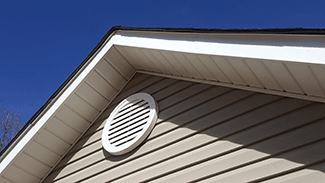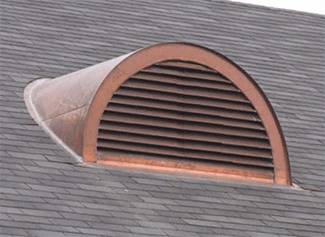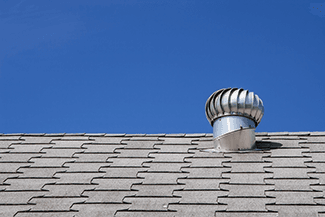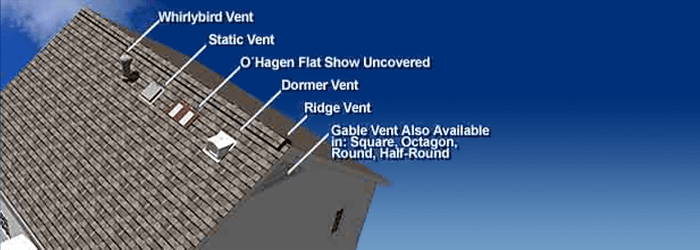Proper Attic Ventilation
If you are looking for ways to reduce heat in your home by adding insulation, a radiant barrier, or fans, hold off, there’s a better way.
Homeowners tend to think that by cooling down the attic, the whole house will become cooler, therefore requiring the air conditioner to run less, resulting in lower utility bills. Sounds good in theory.
In reality, they will be throwing away thousands of dollars in a misdirected effort to save electricity and reduce their bill.
The heat in the attic only affects 10% of the air conditioning bill in one month. Homeowners will never achieve a return on investment by adding thousands of dollars for remedies that will not work.
Assuming the attic is properly insulated to an R-38 and properly ventilated, there is nothing more economical to be done to the attic. Leave the attic alone.
An attic fan, be it solar or electric powered, creates a negative pressure in the attic. Power fans draw air through the attic by creating an airflow. They are effective yet don’t allow natural forces to ventilate the attic. Plus, it’s somewhat expensive to buy and install. Operating power fans costs more than the fan’s benefit. Even fans that automatically turn on and off at selected temperatures are not worth the investment because the summer heat in the attic will cause the fan to run almost continually. So, what you are really will doing is increasing your demand for air conditioning.
There’s a better way – proper passive ventilation and properly installed R38 insulation
There are different kinds of roof/attic vents to consider:
Gable/louvers Vents
 Louvers are covered openings that allow air to escape the attic. They are located on the gable (non-load-bearing) ends of the house and allow limited airflow. This system relies on wind direction to create airflow through the attic. When the wind blows perpendicular to the ridge, it circulates air around the louver, which acts as its own intake and exhaust vent. If the wind blows parallel to the ridge, the airflow pattern acts as a draft that moves in one louver and out the other.
Louvers are covered openings that allow air to escape the attic. They are located on the gable (non-load-bearing) ends of the house and allow limited airflow. This system relies on wind direction to create airflow through the attic. When the wind blows perpendicular to the ridge, it circulates air around the louver, which acts as its own intake and exhaust vent. If the wind blows parallel to the ridge, the airflow pattern acts as a draft that moves in one louver and out the other.
Dormer Vents
 These are very common form of passive attic ventilation in Arizona. Dormer roof vents allow heat to escape from the vent itself and are important to properly cool attic space.
These are very common form of passive attic ventilation in Arizona. Dormer roof vents allow heat to escape from the vent itself and are important to properly cool attic space.
Ridge Vents
Ridge vents are mounted along the top of the ridge of the roof. They provide even and consistent exhaust ventilation. It is best to run a ridge vent the entire length of the attic. Caution: Some roofers cut costs by running only the length required by code. Rosie recommends running the vent from roof end to roof end for best results. A ridge vent won’t work well alone; adequate intake ventilation must accompany the ridge vents in order to maintain airflow.
Soffit Vents
A common method of ventilation, soffit vents, are located under the eaves, where they will have minimal exposure to rain and other weather conditions. Soffit vents on each side of the structure create equal ventilation on both sides. Soffit vents should not be your home’s only vents, though. If they are, the air movement is restricted to the attic floor, and airflow does not pass over the roof sheathing. These vents are how your attic inhales the air it needs to exhale through the passive exhaust system you choose; louver, ridge, dormer, or turbine vents.
Turbine Vents
 Also called whirly birds, turbine vents are wheels mounted near the ridge of the roof. They are usually installed two or three per roof. Most of the time, they act as exhaust vents, but air also can enter the attic through a turbine. Turbine vents are not a good option because they only exhaust small portions of the roof and allow rain to enter the attic.
Also called whirly birds, turbine vents are wheels mounted near the ridge of the roof. They are usually installed two or three per roof. Most of the time, they act as exhaust vents, but air also can enter the attic through a turbine. Turbine vents are not a good option because they only exhaust small portions of the roof and allow rain to enter the attic.
Rosie’s Recommendation: Ridge vents accompanied with soffit vents will create the most effective attic ventilation for your home. The combined system will draw air from the soffits along the sheathing and exhaust it through the ridge vent.
Home Maintenance To-Do | #AtticVentilation
###
PODCAST
Exhausting hot attics with fans and radiant barrier is a waste of money. Rosie explains why natural passive venting is the way to go! Listener questions include a mystery water leak, mounting a flagpole on stucco, popcorn ceiling removal, paver sealing and more!
Photo Credits:
- Weathervane.com
- Shutterstock
RELATED CONTENT
- DIY FAQ: What Is Radiant Barrier?
- DIY FAQ: Why Do I Need To Ventilate My Attic?
- DIY FAQ: How Does Attic Ventilation Work?
- DIY FAQ: Should I Install A Whole House Attic Fan?
















